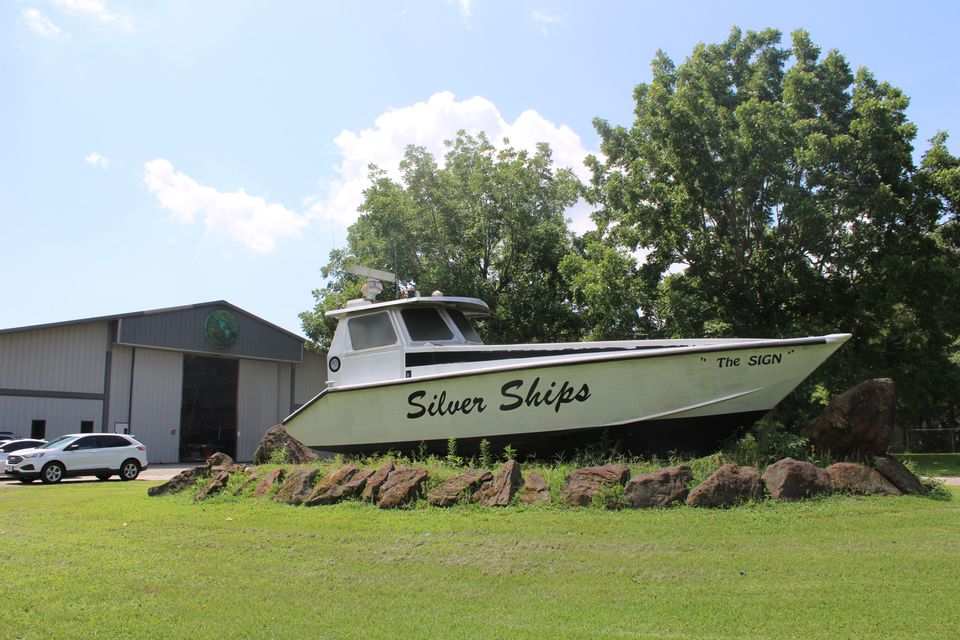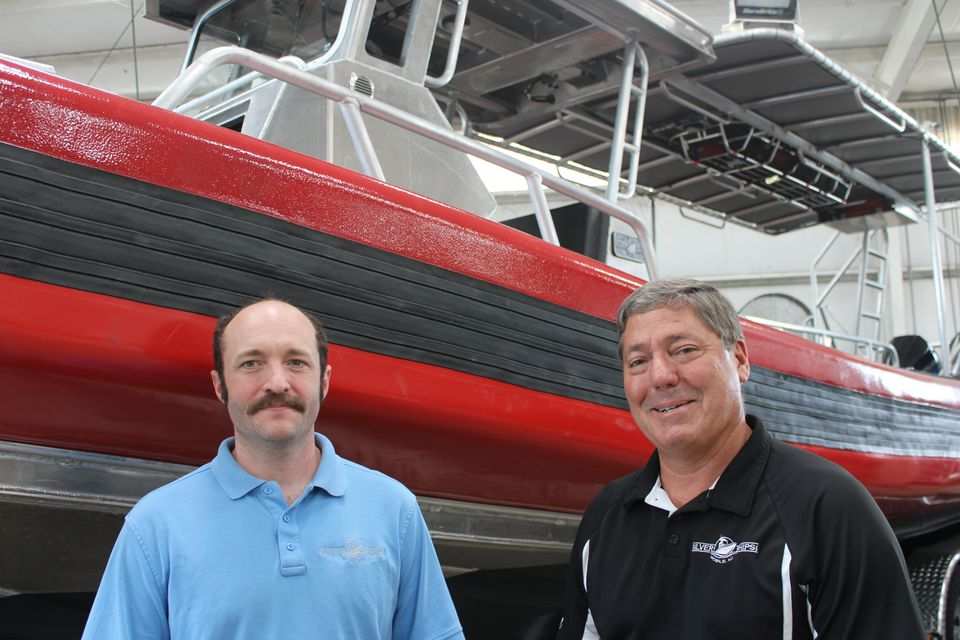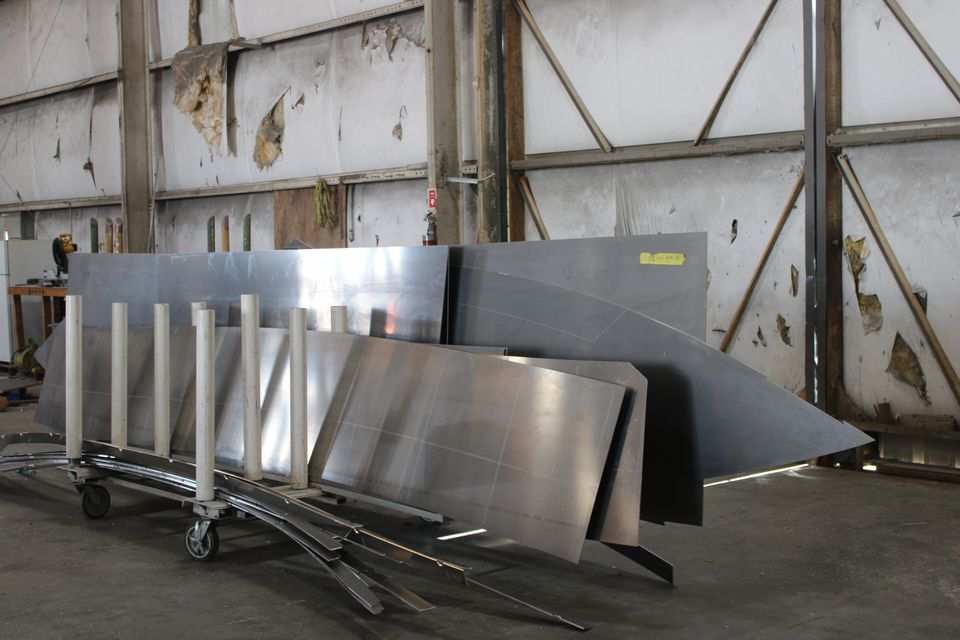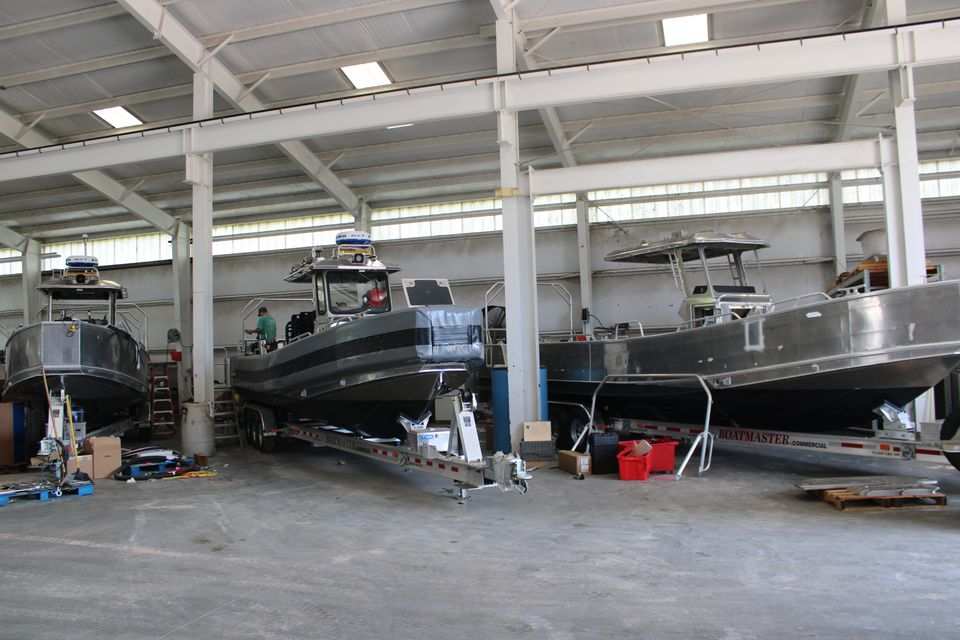If you’ve driven down Bellingrath Road in the last 25 years or so, headed for the historic home and gardens of the same name, you’ve passed an eye-catching landmark: An arrowhead-shaped aluminum boat with “Silver Ships” in script on its side.
“The sign” makes it easy to guess that the warehouses behind the grassy lawn and the one-of-a-kind lawn ornament are home to a shipbuilder. If you know just a little more, you know that Silver Ships builds a lot of boats specifically for the U.S. Navy to shoot at. In fact, the company recently announced the biggest contract in its history, a Navy deal that could be worth over $48 million for nearly 250 of the fast target boats.

But it turns out there’s more to the Silver Ships story than churning out small vessels that are going to be hit with missiles, bombed, and generally shot to tatters. A recent tour of the shipyard found a Gulf Coast business making the most of its multi-building, 32-acre campus.
Dozens of boats in various stages of construction were on site. CEO Steven Clarke estimated there were more than 50 vessels on-site. Some were just kits of cut aluminum plates that hadn’t been welded up into hulls yet; others looked virtually complete. They included target boats, camouflage-painted river patrol boats bound for foreign military service, Coast Guard rapid-response craft, at least one firefighting boat and craft designed for use by Marines and Navy SEALs.
“We’ve grown a lot in the last few years,” said Clarke. Silver Ships’ sweet spot is boats ranging from 20 to 40 feet in length, though it does build some bigger ones. “Any work boat, any patrol boat,” he said. “We do landing craft, catamarans, big monohulls, bay boat style hulls” and more.

The new Navy contract represents a challenge and a growth opportunity for a company that just recently saw its workforce hit triple digits. And that’s not bad, for a company whose creation was more or less accidental.
An uncharted career
Silver Ships was founded by Clarke’s stepfather, Mike McCarty, in 1985. Clarke said that McCarty, a commercial fisherman, had sold a previous company and was planning to go into seine-net fishing. He began building himself a boat for that – the one that now sits in Silver Ships’ front yard – and while he was at it, people began asking him to build boats for them.
“There weren’t a lot of aluminum boat builders,” said Clarke. Between the demand McCarty had stumbled onto, and changes in regulations that made his planned fishing venture less appealing, he became a shipbuilder. By 1990 the company had built its first aluminum Rigid Hull Inflatable Boat (RHIB), a type of design that pairs a solid hull with an inflatable collar that adds buoyancy. It’s a flexible, tough platform that became the basis for many of the boats that Silver Ships would go on to build, including the target boats.
In 1996 the company moved to its current location. A partnership with Ambar Marine provided a pipeline for government work: A few years later, Silver Ships later bought Ambar Marine. By the mid-2000s, Silver Ships was growing by leaps and bounds, thanks in part to a five-year contract to refurbish a fleet of Bridge Erection Boats for the U.S. Army. A 2008 Press-Register story describes the company’s third major expansion project in four years.

Clarke had worked at Silver Ships as a teen but went on to earn degrees in finance and to work on the West Coast. The day came when McCarty began thinking about selling the company and retiring, but there was a problem: Silver Ships was profitable, but after all the growth its books were kind of a mess, Clarke said. That made it hard for a prospective buyer to evaluate things. Clarke spent a little time straightening things out.
Afterward, Clarke said, “he was like, ‘Do you want to come run Silver Ships for me?’ I was like, ‘No.’ I knew how much of a pain it would be.”
Clarke said the sense that his skills were needed, along with the sense that there was still more opportunity ahead of the company, eventually turned that “no” into a “yes.” That was about eight years ago. In 2022, he became CEO as McCarty transitioned to a new role as chairman.
McCarty has moved back to his native Tennessee, Clarke said, but there’s a very distinctive reminder of his presence in the CEO’s office: desk whose granite top rests on a massive frame welded up from aluminum I-beam. It looks like it would serve quite well as a tornado shelter, yet there’s also something playful about it, right down to the custom-anodized color treatment.

Targets built to last
When it comes to the High-Speed Maneuvering Surface Target (HSMST), project manager Shawn Lobree does a lot of the talking. As a former Navy captain, Lobree is familiar with what he calls “the kinetic side” of the concept.
“Before the High-Speed Maneuvering Surface Target came about, HSMST, ships had to improvise for something to shoot at,” he said. “Often they were shooting at the water or maybe a pallet or some kind of improvised target. The Navy needed to develop a fast-moving target for ships to shoot at so they could refine their gunnery skills and have a realistic platform to train with.”
The Navy specified two different styles of target, Lobree said. One is meant to be expended pretty quickly, while the other is designed “to be like Humpty Dumpty, that you can shoot up and then patch back up and use over and over and over again.”
“We need to have this training because our enemies out there have capabilities of being able to throw some fast-moving things at us, and lots of them,” Lobree said. “So this boat is just tremendously valuable to give the Navy advanced training, to sharpen their skills before going overseas.”

The HSMST that Silver Ships delivers to the Navy is based on the company’s 27-foot AM800, part of a family of RHIBs called the Ambar series. They range from the 20-foot AM600 up to the 40-foot AM1200. Boats in the family serve a wide range of missions for customers that include multiple branches of the military and a variety of law-enforcement and emergency-response agencies. Silver Ships has delivered more than 800 of them to the Navy since 1994. It’s a “workhorse” platform, Lobree said.
You might think that if you know you’re building something just to be blown up, you think of it as disposable. The folks at Silver Ships say that’s not their point of view at all.
The company’s in-house design team inhabits a building built as a residence. Because of its red roof, it’s known internally as “the pizza hut.” Among those who work there are naval architects Clayton Danielson and Reilly O’Connor and marine designer Ben Bates.
“We design every boat here to last a lifetime,” said Danielson. “We design it to be maintained.”

“The importance of that vessel doing exactly what it needs to do … we really have to build the boat, even if they’re going to destroy it, as a top-notch piece of equipment,” said Bates. “And the same standards that revolve around our other contracts really apply to that one as well.”
“We really don’t let the guys around here get the idea that, well, this is a destructible product, so you don’t have to care about the work you put into it,” he said. “We take every boat and we build it to the best of our ability before we supply it to the customer.”
O’Connor brings up a story from a couple of years ago that made international headlines. In September 2019, the crew of an Irish ferry serving islands on the west coast of Ireland spotted a mostly submerged hull adrift in the sea. They towed it to land, where everything about it caused a stir. According to an Irish Times report, distinctive features included a bright orange paint job, a heavy coating of barnacles and seaweed, bullet holes and damage from an explosion.

“It was rough,” said O’Connor.
The mystery didn’t last long, given that the boat had a serial number. A report in The Virginian-Pilot nailed down its origins: Built by Silver Ships in 2015 for the U.S. Navy, it had been lost off Norfolk, Va., during a missile test exercise in September 2018. When the test team couldn’t find it afterward, they reported it as a potential navigation hazard. Over the next year, it drifted about 3,400 miles. (As with many of Silver Ships’ RHIBs, the collar was mostly made of a tough foam, rather than an inflatable bladder, so it provides flotation even when heavily damaged.)
“The boat got patched up and is in service as a workboat,” said Danielson.
“Aluminum is a product that can survive those types of things and be repaired to almost like-new functionality,” said Bates. “They can patch it up massive ordinance holes in that boat … If you hit fiberglass like that, you’re not going to be able to bring that back.”
The pizza hut guys have their favorites. There’s a 43-foot Coastal Fast Response Boat that goes to a U.S. Navy Foreign Military Sales Program and a Special Purpose Craft for the Coast Guard. A special place of honor goes to the Tobin, a 49-foot boat specifically designed for the U.S. Army Corps of Engineers to map the ever-changing terrain at the mouth of the Mississippi River. Delivered in 2022, it was named one of the 10 most significant boats of the year by industry publication www.workboat.com.
Danielson said the Tobin is a prime example of the way Silver Ships is willing to work with customers to tailor a vessel to their exact needs.

“It’s always rewarding and satisfying to talk to the end users,” he said. “Whereas our work environment is this office, oftentimes their work environment is in our boats.”
‘That’s a lot of boats’
Elsewhere in the yard, the variety of boats is obvious, but that’s not necessarily true of their specific destinations. In one building, stacks of aluminum plates are welded up into upside-down hulls. Some of the hulls have an inconspicuous “NSW” among the information written on their bows. That means “Naval Special Warfare,” Lobree said. They’ll be used by “the SEAL community” for swim and dive training.
In other buildings, boats have their superstructures, motors and other fixtures added, before they move to final outfitting. The buildings are full, with boats seemingly in every bay. There’s a firefighting boat going to a customer in Florida. With three big outboards, Lobree said, “it might be the fastest boat we’ve ever built.” Near it sits an Amphibious Assault Safety Boat, which will support Marine training exercises.
Coordinating their advancement from one stage to the next is a big job. Not to mention that every boat gets a full test run in Mobile Bay or Fowl River before it’s delivered. “People ask me what I do all day,” said Clarke. “At least half is logistics.”
Many of the boats are destined not for the military but for various state and local agencies. Clarke said that has been the biggest growth area for Silver Ships in recent years. “We have a very diverse customer base,” said Lobree.
None of this was guaranteed a couple of years ago, as supply-chain woes racked the company during the COVID-19 pandemic. It was a “horrible” time, Clarke said.
“Lots of sleepless nights,” said Clarke. “You had million-dollar-plus boats waiting on a handful of parts.”
“I was telling people in 2021 I didn’t know if we were going to make it,” he said. “It was that bad. If you can’t finish boats, you can’t get paid. But things are very different now. I would not say things are back to 2019 … but I’ll take this over 2021, 2022, any day.”
The outlook is good: The need for target ships doesn’t seem like something that’s going to fade away anytime soon. It’s been 23 years since a small, explosive-laden boat nearly sank the USS Cole, but the incident hasn’t been forgotten. And in more recent years, the threat of similar suicide attacks has been overshadowed by the emerging threat of drone attacks. It’s not at all hard to imagine a scenario where Navy gunners will urgently need to hit small incoming craft.
“Absolutely,” said Clarke. “And that’s what the Navy has told us. I think that’s why this new contract is so big.”
The initial award is for 37 target boats, Lobree said, but the contract includes options that could bring the total to 246. No wonder the company will soon be adding a weekend shift.
“That’s a lot of boats,” said Lobree.
“It’s a step up, because we have so much work now,” said Clarke. “But we’re comfortable taking that step, because it’s something we have so much experience with.”
___
© 2023 Advance Local Media LLC
Distributed by Tribune Content Agency, LLC.



